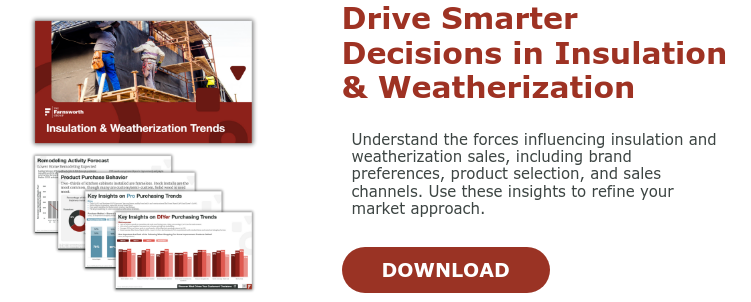The market for insulation, waterproofing, and weatherization products was sluggish in 2024. However, research indicates this specific market segment has started to rebound in 2025 and will continue to grow in 2026.
Awareness around energy efficiency, indoor air quality, resiliency, and sustainability are driving demand for renovations and improvement projects that can address these concerns and challenges. Not only is that expected to help boost the market growth for existing products and technologies, but there is also a growing need for new alternatives and substitutes to address customer usage and preferences.
What is the Size of the Insulation, Weatherization, and Weatherproofing Market?
There is plenty of intersection among weatherization, waterproofing, and insulation products, with a variety of them being used for specific renovations and home improvement activities.
Based on S&P Global’s data provided to the Home Improvement Research Institute’s members in the September 2025 Size of Market Forecast, there is positive growth for both the professional and consumer markets between 2025 to 2028.
Although there is some crossover in the types of products and materials used for thermal insulation versus acoustic insulation, there are also distinctions between these product categories and their respective markets. The global market value for acoustic insulation products is expected to approach approximately $17 billion by 2026.
Why is the Insulation and Weatherization Products Category Expected to Increase in 2026?
With the expectation for a rebound in these product categories, you need to understand what market trends, customer behaviors, and other factors are likely to contribute to this growth over the next few years.
Here are a handful of the reasons why the market for insulation, waterproofing and weatherization products is expected to grow in 2026:
1. Rising Energy Costs
Currently, inflation is prevalent across industries and markets, which is presenting higher costs to consumers for their daily needs, including energy. According to the U.S. Energy Information Administration, the average U.S. residential electricity price increased 5.11% YoY as of May 2025. Homeowners and tenants are looking for ways to reduce their utility bill amid fluctuating costs, and that includes improving insulation and weatherization.
2. Desire to Protect Home from Natural Disasters
There have been 387 weather and climate disasters since 1980 where overall damages/costs reached or exceeded $1 billion (including CPI adjustment to 2024), according to NOAA. These large events continue to increase; in the 90s there were an average of 5.7 per year, 6.7 in the 2000s, 13.1 in the 2010s, to averaging 20.4 in the past five years. In 2023, a year of historical highs, there were 28 $1B+ natural disasters in the U.S. So far in 2025, there have been 14.
In light of fires, flooding and storm challenges, property owners are likely to turn to products that can help with basement waterproofing, home exterior waterproofing, fire mitigation, protecting roofs from weather damage, and other projects to protect their homes and other structures from natural disasters.
Additionally, weather resistance is expected to become an even bigger focus over the next few years, not only in the United States but also abroad. This emphasis on resiliency and sustainability are likely to help drive the weatherization and waterproofing markets and create new opportunities for building product manufacturers in these industries.
3. Failing Infrastructure and Rapid Industrialization
Another factor influencing the insulation and weatherization market is the aging of infrastructure and buildings that’s happening internationally. The median age of a home in the U.S. is over 40 years according to the NAHB. They are in need of upgrades to improve energy efficiency and insulation, such as tighter envelopes, air sealing, and conditioned crawlspaces, as well as roof repairs and other retrofitting activities. There’s a growing understanding of how upgrading old infrastructure and retrofitting aging buildings with newer technology can reduce utility bills, the strain on the electric grid, and climate pollution while improving the health of residents and tenants.
With investments being made to meet the demands of rapid industrialization and improving infrastructure, there is a growing need for construction materials—particularly in the insulation, weatherization, and waterproofing market—that can contribute to energy efficiency, resiliency, and creating a safe, healthy environment, whether a building is used for residential, commercial, or industrial purposes.
4. Demand for Alternative Materials
Last year, the mineral wool segment held the most significant share among building insulation materials[K4], thanks to its superior thermal and acoustic insulation properties and the increasing consumer demand for high-quality construction products and materials.
Manufacturers are also developing synthetic materials that have waterproofing properties and mimic looks of slate, wood, metal, but are made from more sustainable, lighter, easier to install, and more affordable composites. Homeowners that want to achieve a wood look on the exterior of their home no longer need to invest in the high cost of cedar shake and shingles for example. Instead, they can select from a range of wood-look siding shapes and sizes. This trend is also happening in the roofing category with the increased share of metal roofs that tend to be more environmentally friendly and durable.
5. Increasing Push for Healthy Homes
Exposure to the toxic chemicals used in building insulation materials can lead to various human health and safety risks, and there is a growing awareness around this issue. Industry stakeholders and customers are on the lookout for new insulation alternatives that are safer and more sustainable.
Not only that, but the concept of healthy homes has been more top-of-mind since the COVID-19 pandemic, and proper weatherization of residential and commercial buildings can improve certain aspects of indoor air quality (IAQ) and the overall comfort of an indoor space.
These attributes are increasingly meaningful to homeowners, particularly younger generations and those with children in the household. They are also increasingly important to price-sensitive and health-conscious renters, who desire updated ventilation control systems; general air sealing and insulation; and high-efficiency HVAC components.
However, these growing concerns about the health and safety risks posed by certain materials, like mineral wool and fiberglass, will influence the market for these products in the coming years and continue to drive the desire for safer alternatives.
6. Emergence of Innovations
For several of the reasons mentioned above, there’s been the emergence of new innovations within the insulation and weatherization industries—and there continues to be new opportunities for building product manufacturers to meet the demand for improved insulation materials and better waterproofing technology.
A few examples of emerging alternatives and innovations within these industries include vacuum insulation panels, smart insulation, green waterproofing products (i.e. low-VOC,polymer-based, and recyclable), better-performing housewraps, and integrating renewable energy into the weatherization process. In some cases, it’s not about introducing new products and materials, but finding ways to make them more accessible and cost-competitive to residential customers.
A couple of examples are the use of carbon fiber in basement crack repair and spray-on air and vapor barriers. Along with better quality, there’s also an emphasis on better craftsmanship and ensuring that these products and materials are installed correctly to optimize their benefits, from mitigating the risk of building damage to enhancing efficiency and improving comfort for occupants.
Core Growth Limitors
1. Labor Shortages Present Market Constraints
Across nearly every trade, labor availability remains one of the top challenges facing contractors. According to our Q3 2025 Farnsworth Contractor Index, over half of pros report difficulties hiring skilled labor, and confidence in having enough labor over the next year remains moderate at around 7.7 out of 10.
"We're hearing how rising labor costs are putting additional pressure on project timelines and profitability. This means manufacturers have an opportunity, and responsibility, to act as true partners in helping pros do more with less. Products that are faster to install, require fewer specialized skills, or reduce callbacks can directly ease the strain caused by limited labor."
- Taylor Pence, Senior Advisor
Whether through simplified application systems, better packaging, or on-site technical support, brands that help tradesmen save time and reduce rework are poised to win long-term loyalty in today’s constrained labor market.
2. Scheduled End of Tax Incentives in December 2025
The insulation and weatherization category faces a slight headwind as federal incentives for energy-efficient home improvements expire on December 31, 2025. Programs offering tax credits and rebates for insulation, windows, and air sealing are being reduced or terminated by the Department of Energy, creating uncertainty for property owners and contractors. Recent research from the Home Improvement Research Institute on the impact of Government Incentives and Energy Retrofit programs reveals a smaller impact on purchasing decisions than may have been supposed, especially among specific target demographics.
With fewer financial incentives driving adoption, demand may soften, particularly among cost-sensitive households. While limited programs like the Weatherization Assistance Program will remain, overall market growth will increasingly depend on state-level support and private innovation rather than broad federal funding.
3. Macro-Economic and Housing Market Conditions Temper Near-Term Growth
While inflation is moderating and the Fed has begun small rate cuts, high borrowing costs and limited affordability continue to constrain discretionary home improvement spending. Real disposable income and consumer sentiment are projected to improve into 2026, yet many households remain cautious amid lingering economic uncertainty.
At the same time, low housing turnover and steady, but not expanding, new construction are restraining large-scale remodeling activity. As home prices stabilize and affordability gradually improves, spending is likely to shift from essential maintenance to selective upgrades, delaying stronger category growth until beyond 2025.
Staying Up to Date with the Insulation, Weatherization and Waterproofing Markets
With growth expected over the next few years for weatherization, insulation, and waterproofing products, there are going to be new opportunities for weatherization and insulation manufacturers and distributors to meet changing demand and acquire a larger share of the market.
Whether it’s a homeowner looking to upgrade for energy efficiency or an architect looking to utilize new materials in a creative fashion, you must understand what customers want so you can better meet their needs.
Our industry research experts at The Farnsworth Group have been studying the building products space exclusively for nearly four decades, and understand the nuances of our current environment. We are here to help your product, channel, brand, and marketing teams understand customer behavior, market sizing, and product preferences that are most relevant to making strategic business decisions.





